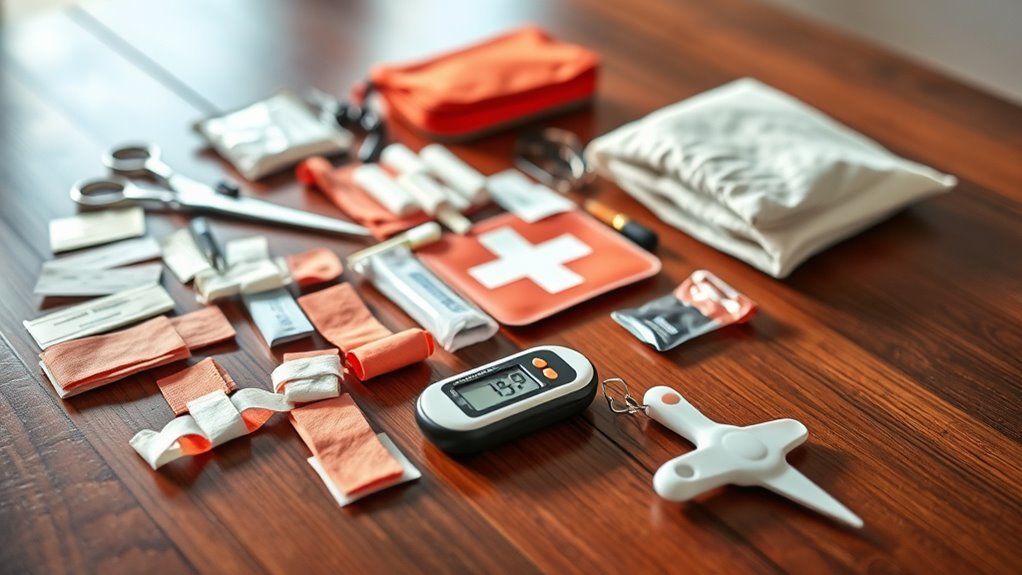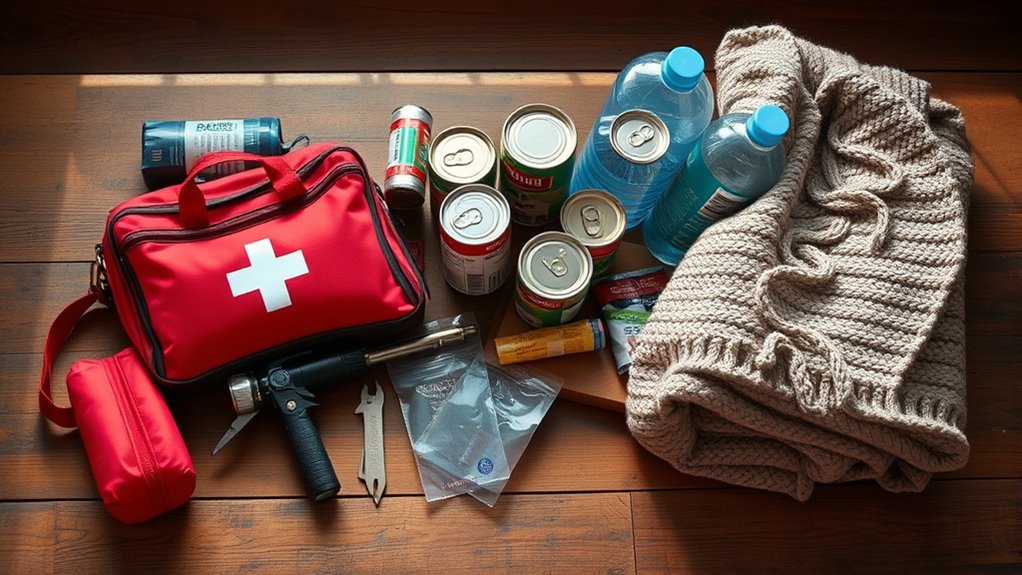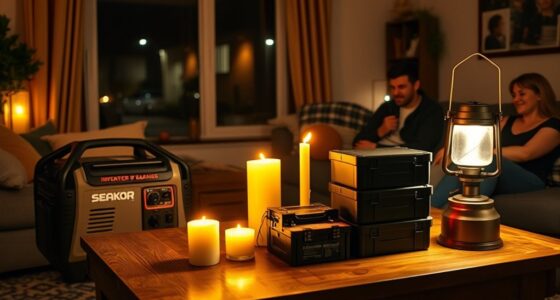Creating an emergency kit is vital for your safety. Start with non-perishable food items like canned goods, nuts, and granola bars. Don’t forget at least one gallon of water per person per day for three days. Include a first aid kit with adhesive bandages and essential medications. Add a flashlight, portable charger, and disposable hygiene products. Also, gather important personal documents. By regularly checking and updating your kit, you guarantee it always meets your needs and situations.
Key Takeaways
- Include non-perishable food items like canned goods, dried fruits, and nuts to ensure nutrition during emergencies.
- Pack a well-stocked first aid kit with bandages, essential medications, and hygiene supplies for health and safety.
- Store at least one gallon of water per person per day for three days, ensuring fresh supplies.
- Equip your kit with reliable lighting, communication tools, and air quality safety items like flashlights and HEPA filters.
- Keep important personal documents in a waterproof container, including identification and medical records, for easy access during crises.
Importance of Emergency Preparedness

Emergency preparedness is essential because it equips you with the supplies needed to respond effectively during disasters.
Having a well-stocked emergency kit that’s easy to carry can make a significant difference in both home safety and evacuation scenarios. You should regularly update and check your survival kit to guarantee the contents remain relevant and useful for various emergencies. Including non-perishable items in your kit ensures you have sustenance during extended emergencies. Additionally, incorporating water purification methods into your kit can ensure you have safe drinking water in times of crisis. Consider adding multi-functional gear to your kit to maximize space and enhance your preparedness. A well-prepared kit can also help you engage in outdoor activities safely during emergencies, ensuring you’re equipped for any situation that arises. Don’t forget to take into account your personal needs when assembling your kit; tailor supplies to fit your specific health, dietary, or situational requirements. Remember, having a thorough understanding of emergency preparedness essentials can greatly enhance your ability to adapt during crises.
Essential Non-Perishable Food Items

When disaster strikes, having essential non-perishable food items in your emergency kit can make all the difference in keeping your energy up and maintaining nutrition. It’s vital to pack a variety of foods that require minimal preparation and have a long shelf life. Aim for at least a three-day supply per person, totaling around 2,000 calories daily. Additionally, mixed herds of livestock can provide a sustainable food source if you have the capability to raise them. Having a reliable source of renewable resources can also be beneficial for long-term sustainability during emergencies. Remember that establishing a routine of spiritual reflection can also help maintain mental resilience during challenging times. Including portable camping toilets in your emergency kit can also enhance comfort and hygiene during extended crises.
Here are four must-have items to take into account:
- Canned goods (vegetables, beans, and fruits)
- Dried fruits (raisins, apricots, or apples)
- Nuts (almonds, walnuts, or peanuts)
- Granola bars (for quick energy)
Additionally, consider storing fresh produce in greenhouses, as it can provide essential vitamins and minerals when non-perishables run low. Don’t forget to account for dietary restrictions, ensuring everyone in your family has access to nutritious food during emergencies.
Water Supply and Purification

Having a reliable water supply is essential for survival during any crisis, as staying hydrated can greatly impact your health and well-being. Aim to store at least one gallon of water per person per day for a minimum of three days. This guarantees adequate hydration when you need it most. Moreover, understanding the importance of energy-efficient technology can help you save resources during emergencies. In addition, having access to advanced purification methods ensures that you can convert contaminated water into safe drinking water effectively.
Incorporating energy-efficient solutions can also enhance the effectiveness of your emergency preparedness efforts. Don’t forget about water purification methods; boiling, chemical disinfection, and filtration can make contaminated water safe to drink. Include portable water filters and purification tablets in your emergency kit for effective treatment on the go. Additionally, natural purification strategies can be helpful in situations where conventional methods are unavailable.
Regularly check and replace stored water every six months to maintain freshness. Additionally, consider adding a water storage container or collapsible bags to your kit for easy transport and storage of emergency water supplies. Understanding the importance of long-term financial planning can also help ensure you have the resources to obtain necessary supplies during emergencies.
First Aid Kit Essentials

Here are four must-have essentials:
- Adhesive bandages in various sizes for cuts and scrapes.
- Sterile gauze pads and adhesive tape to cover larger wounds.
- Essential medications like aspirin and antihistamines for pain and allergic reactions.
- CPR face shield or mask along with a first aid manual for guidance. Advance directives can also be essential in ensuring that your medical wishes are known during an emergency. Having a well-prepared emergency kit can be a vital part of empowering families to respond effectively in critical situations. Additionally, it is beneficial to understand the importance of emotional support during emergencies to help manage stress and anxiety. Engaging in pet therapy can also provide comfort and companionship for individuals experiencing distress in emergency situations.
Don’t forget to include scissors, tweezers, and disposable gloves to guarantee safe treatment. Additionally, consider the importance of color accuracy when choosing any medical devices with screens, as it can impact visibility and comprehension during emergencies.
Regularly check your kit and refresh its contents, making sure everything is up-to-date and meets your family’s health needs.
Emergency Lighting and Communication

When an emergency strikes, having the right lighting tools and communication devices is essential.
You’ll want battery-operated lanterns or flashlights to help you see and navigate safely in the dark.
Plus, a reliable way to stay connected, like a solar-powered charger or a whistle, can make all the difference in reaching help when you need it most. Additionally, ensuring good indoor air quality can help maintain your well-being during emergencies when you may be confined indoors.
Essential Lighting Tools
In any emergency situation, having reliable lighting tools is essential for safety and communication. You’ll want to make sure your kit includes the following items:
- LED Flashlights – They provide brighter light and can last up to 100,000 hours.
- LED Lanterns – Perfect for illuminating larger areas, they also have long battery life.
- Extra Batteries – Always pack spares for your lighting devices; you may need them for extended outages.
- Glow Sticks – Lightweight and battery-free, they’re a great long-lasting alternative for light. Regularly checking your emergency supplies will ensure you are always prepared. Additionally, having HEPA filtration in your emergency kit can help improve air quality if you face dust or smoke during an emergency. It’s also important to ensure that your pets are safe from toxic foods such as grapes during emergencies when you may be stressed and less attentive.
Consider adding a portable solar charger too, as it can recharge your devices while providing light. Additionally, being aware of toilet maintenance practices can help prevent sanitation issues during emergencies when plumbing may be disrupted.
These tools will keep you safe and help you navigate through any unexpected situation.
Communication Devices Needed
Effective communication is essential during emergencies, and having the right devices in your kit can make all the difference.
Start with a reliable battery-operated or hand-crank radio to receive important updates when power’s out. Equip yourself with flashlights and extra batteries, or opt for solar-powered lights to navigate safely in the dark.
Don’t forget a whistle; it’s more effective than shouting when you need to signal for help. Portable phone chargers or power banks are vital for keeping your devices charged, ensuring you can stay in touch with family and emergency services.
Finally, include a multi-tool or Swiss Army knife in your kit—it can assist with various tasks and enhance your overall preparedness during emergencies.
Personal Hygiene and Sanitation Supplies

When packing your emergency kit, don’t overlook personal hygiene and sanitation supplies.
Essential items like hand sanitizer, soap, and waste disposal solutions are vital to keeping you healthy during a crisis.
Make sure to tailor your selections to your specific needs to stay prepared and comfortable.
Essential Hygiene Products
Maintaining personal hygiene during emergencies is essential for your well-being. An effective emergency kit should include hygiene products that help you stay clean and healthy.
Here’s a list of must-have items:
- Hand sanitizer – to keep your hands clean when soap and water aren’t available.
- Toothbrush and toothpaste – for maintaining dental hygiene and fresh breath.
- Sanitary supplies – including menstrual products and baby wipes, ensuring comfort during extended crises.
- Disinfecting wipes and tissues – to sanitize surfaces and manage waste effectively.
Regularly check your kit for expired items and tailor your supplies to your specific needs.
Waste Disposal Solutions
While you may not think about waste disposal in everyday life, having proper solutions in your emergency kit is essential for maintaining sanitation and hygiene. Include portable toilet solutions like disposable toilet bags or chemical toilets to manage waste safely. Don’t forget feminine hygiene products such as pads and tampons, as these are critical during emergencies. A sanitation kit with gloves, masks, and disinfectant is crucial for preventing the spread of germs in confined spaces. Regularly check your supplies to guarantee they’re effective and safe to use.
| Item | Purpose |
|---|---|
| Disposable Toilet Bags | Safe waste disposal |
| Chemical Toilets | Portable sanitation |
| Feminine Hygiene Products | Personal care during emergencies |
| Gloves | Protect against germs |
| Disinfectant | Maintain cleanliness |
Hand Sanitizing Options
Proper waste disposal is just one aspect of hygiene during emergencies. Keeping your hands clean is essential, and choosing the right sanitizing options can make all the difference.
Here are four must-have items for your emergency kit:
- Alcohol-based hand sanitizer (at least 60% alcohol) – vital for killing germs.
- Individual-sized sanitizer bottles – portable and easy to carry in pockets or bags.
- Antibacterial wipes – a great alternative when soap and water aren’t available.
- Moisturizing hand sanitizer – helps prevent skin irritation from frequent use.
Regularly check expiration dates to guarantee effectiveness.
Having these items handy will help you maintain personal hygiene during emergencies, making you feel safer and more prepared.
Important Personal Documents

When an emergency strikes, having your important personal documents readily accessible can make a significant difference.
Include identification cards like your driver’s license or passport to verify your identity when it matters most. Don’t forget copies of essential documents such as birth certificates, social security cards, and insurance policies; these contain crucial information you’ll need quickly.
Store everything in a waterproof and fireproof container to protect against damage during disasters. Additionally, consider including your medical records and a list of medications to guarantee you can access necessary health information.
Finally, remember to regularly update these documents to reflect any changes, like new insurance coverage or updated IDs, so you’re always prepared.
Regular Maintenance and Updates for Your Kit

To guarantee your emergency kit remains effective, it’s essential to maintain and update it regularly. Check your kit at least every six months to verify all supplies are accounted for and in good condition.
Regularly check and update your emergency kit every six months to ensure all supplies are in good condition and accounted for.
Here are some key updates to take into account:
- Replace perishable items like food and medications to avoid expired products.
- Tailor your kit to changing personal needs, adding baby supplies or pet essentials as your family grows.
- Keep a record of contents and their expiration dates to streamline maintenance.
- Adjust for seasonal changes and new risks, confirming you’re prepared for different types of emergencies.
Frequently Asked Questions
What Are 10 Things You Should Have in an Emergency Kit?
You should have several essential items in your emergency kit.
Start with at least one gallon of water per person per day for at least three days. Pack non-perishable food items, a first aid kit with necessary medications, and a flashlight with extra batteries.
Don’t forget a multi-tool for various tasks. Additionally, include a whistle to signal for help, a dust mask for filtering air, a local map, and personal hygiene items.
What Are the 7 Supplies That Are Needed for an Emergency Supply Kit?
When you think about preparing for emergencies, consider both essentials and comforts.
You’ll need water, food, and a first aid kit to stay safe and nourished. A flashlight brings light where it’s dark, while batteries keep it running.
Don’t forget a multi-tool for those unexpected tasks. Finally, pack a whistle for signaling help if you need it.
These supplies guarantee you’re ready, no matter what situation arises.
What Are 20 Things You Would Find in an Emergency Kit?
In an emergency kit, you’d find essential items like non-perishable food, water, and a flashlight with extra batteries.
You’d also have a first aid kit, a multi-tool, and personal documents stored in a waterproof container.
Don’t forget a whistle for signaling, a blanket for warmth, and a portable phone charger.
Other useful items include matches, a map, hygiene products, a radio, and a poncho, ensuring you’re well-prepared for any situation.
What Items Should I Stockpile for an Emergency?
Picture a ship maneuvering through a storm; you need supplies to weather the waves.
For your journey, stockpile essentials like water, non-perishable food, and first aid items.
Don’t forget a flashlight to pierce the darkness and personal hygiene items to keep spirits high.
Secure important documents in a waterproof container, so they stay safe.
With these provisions, you’ll be ready to face any tempest life throws your way.
Conclusion
In the end, you never know when an emergency might strike—just like that time your neighbor’s tree fell during a storm, leaving them without power for days. By creating an emergency kit, you’re not just preparing for the unexpected; you’re empowering yourself and your loved ones. So, gather those must-have items, keep your kit updated, and rest easy knowing you’re ready for whatever comes your way. It’s better to be safe than sorry!










